A Report on Research and Decision Making: Impacts on Business
VerifiedAdded on 2023/06/12
|10
|2073
|429
Report
AI Summary
This report provides an analysis of business decision-making, focusing on the impacts of Generation Y on these processes. It covers various research designs, including explanatory, exploratory, descriptive, diagnostic, and experimental designs, ultimately concluding that an exploratory research design is most suitable for the study. The report identifies key variables, such as business decision-making as a dependent variable and generational differences (Generation X and Y) as independent variables. It discusses sampling requirements, comparing probability and non-probability sampling methods, and details the use of random sampling in this context. Finally, the report addresses ethical issues in research, including informed consent, beneficence, anonymity, and confidentiality. Desklib offers similar solved assignments and past papers for students.

Running head: RESEARCH AND DECISION MAKING
Research and Decision Making
Name of Student:
Name of University:
Author’s Note:
Research and Decision Making
Name of Student:
Name of University:
Author’s Note:
Paraphrase This Document
Need a fresh take? Get an instant paraphrase of this document with our AI Paraphraser

1RESEARCH AND DECISION MAKING
Executive Summary:
The aim of the report is to cover the analysis of business decision or problem, the details
regarding the research design, variable identification and understanding, sample requirements,
and also the ethical issues which might come up in the research.
Executive Summary:
The aim of the report is to cover the analysis of business decision or problem, the details
regarding the research design, variable identification and understanding, sample requirements,
and also the ethical issues which might come up in the research.
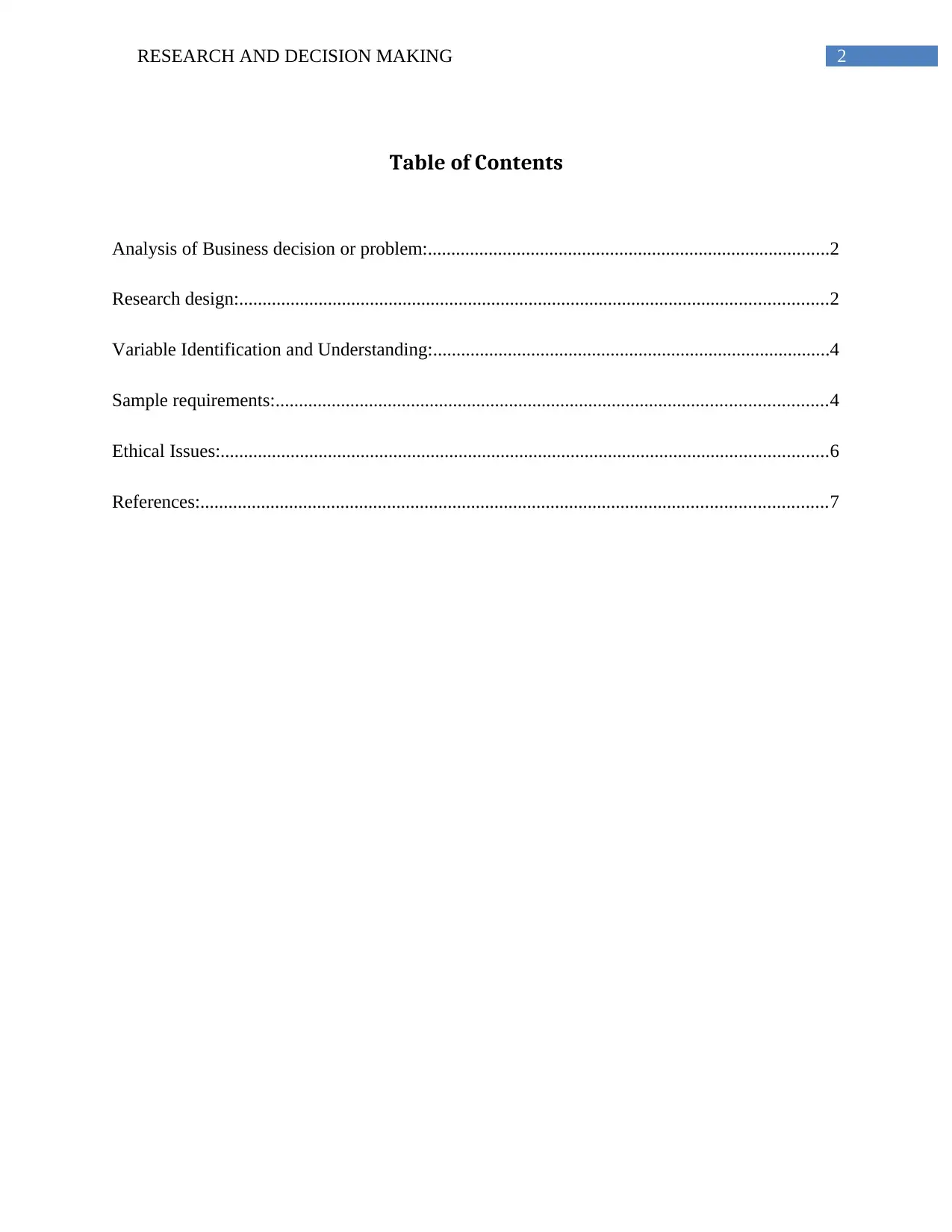
2RESEARCH AND DECISION MAKING
Table of Contents
Analysis of Business decision or problem:......................................................................................2
Research design:..............................................................................................................................2
Variable Identification and Understanding:.....................................................................................4
Sample requirements:......................................................................................................................4
Ethical Issues:..................................................................................................................................6
References:......................................................................................................................................7
Table of Contents
Analysis of Business decision or problem:......................................................................................2
Research design:..............................................................................................................................2
Variable Identification and Understanding:.....................................................................................4
Sample requirements:......................................................................................................................4
Ethical Issues:..................................................................................................................................6
References:......................................................................................................................................7
⊘ This is a preview!⊘
Do you want full access?
Subscribe today to unlock all pages.

Trusted by 1+ million students worldwide
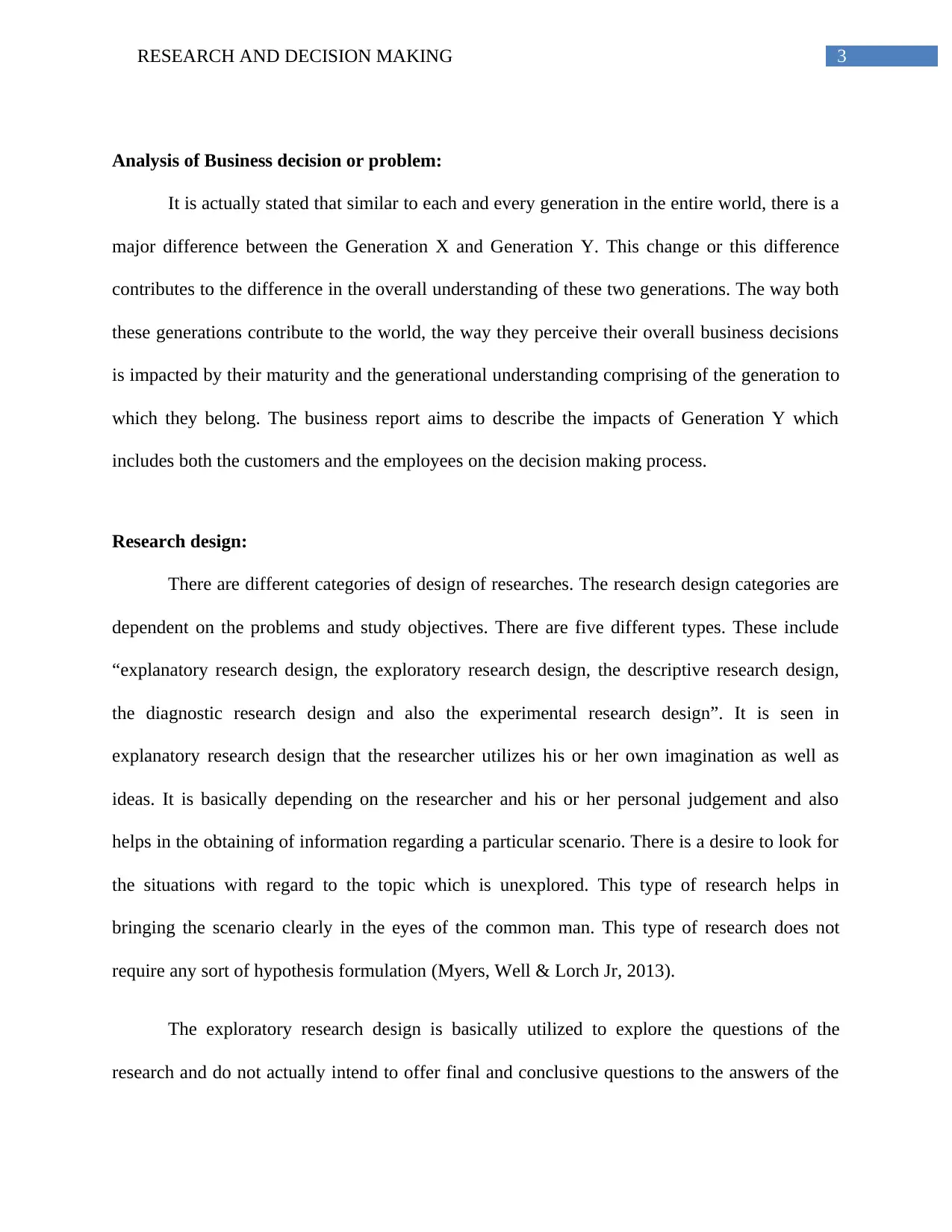
3RESEARCH AND DECISION MAKING
Analysis of Business decision or problem:
It is actually stated that similar to each and every generation in the entire world, there is a
major difference between the Generation X and Generation Y. This change or this difference
contributes to the difference in the overall understanding of these two generations. The way both
these generations contribute to the world, the way they perceive their overall business decisions
is impacted by their maturity and the generational understanding comprising of the generation to
which they belong. The business report aims to describe the impacts of Generation Y which
includes both the customers and the employees on the decision making process.
Research design:
There are different categories of design of researches. The research design categories are
dependent on the problems and study objectives. There are five different types. These include
“explanatory research design, the exploratory research design, the descriptive research design,
the diagnostic research design and also the experimental research design”. It is seen in
explanatory research design that the researcher utilizes his or her own imagination as well as
ideas. It is basically depending on the researcher and his or her personal judgement and also
helps in the obtaining of information regarding a particular scenario. There is a desire to look for
the situations with regard to the topic which is unexplored. This type of research helps in
bringing the scenario clearly in the eyes of the common man. This type of research does not
require any sort of hypothesis formulation (Myers, Well & Lorch Jr, 2013).
The exploratory research design is basically utilized to explore the questions of the
research and do not actually intend to offer final and conclusive questions to the answers of the
Analysis of Business decision or problem:
It is actually stated that similar to each and every generation in the entire world, there is a
major difference between the Generation X and Generation Y. This change or this difference
contributes to the difference in the overall understanding of these two generations. The way both
these generations contribute to the world, the way they perceive their overall business decisions
is impacted by their maturity and the generational understanding comprising of the generation to
which they belong. The business report aims to describe the impacts of Generation Y which
includes both the customers and the employees on the decision making process.
Research design:
There are different categories of design of researches. The research design categories are
dependent on the problems and study objectives. There are five different types. These include
“explanatory research design, the exploratory research design, the descriptive research design,
the diagnostic research design and also the experimental research design”. It is seen in
explanatory research design that the researcher utilizes his or her own imagination as well as
ideas. It is basically depending on the researcher and his or her personal judgement and also
helps in the obtaining of information regarding a particular scenario. There is a desire to look for
the situations with regard to the topic which is unexplored. This type of research helps in
bringing the scenario clearly in the eyes of the common man. This type of research does not
require any sort of hypothesis formulation (Myers, Well & Lorch Jr, 2013).
The exploratory research design is basically utilized to explore the questions of the
research and do not actually intend to offer final and conclusive questions to the answers of the
Paraphrase This Document
Need a fresh take? Get an instant paraphrase of this document with our AI Paraphraser
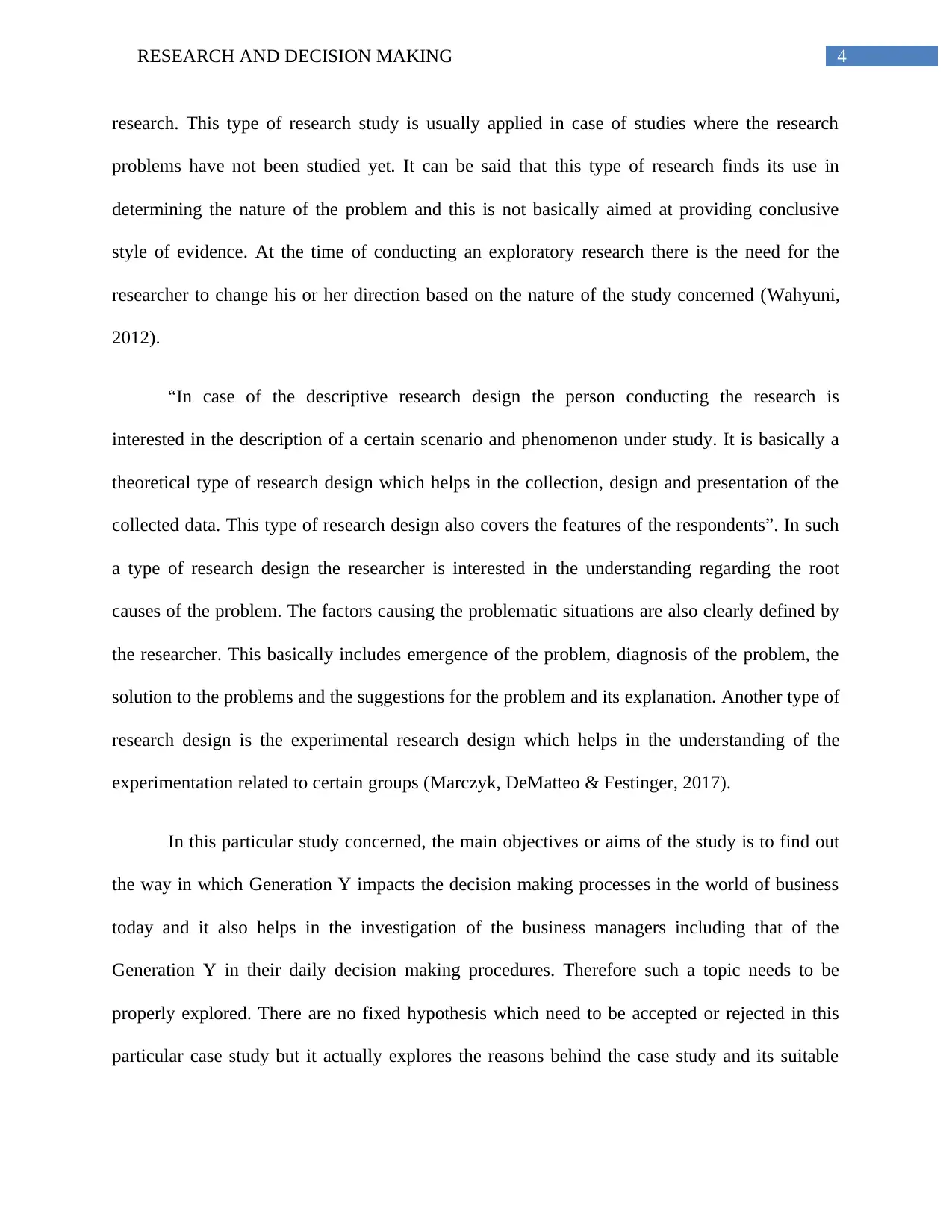
4RESEARCH AND DECISION MAKING
research. This type of research study is usually applied in case of studies where the research
problems have not been studied yet. It can be said that this type of research finds its use in
determining the nature of the problem and this is not basically aimed at providing conclusive
style of evidence. At the time of conducting an exploratory research there is the need for the
researcher to change his or her direction based on the nature of the study concerned (Wahyuni,
2012).
“In case of the descriptive research design the person conducting the research is
interested in the description of a certain scenario and phenomenon under study. It is basically a
theoretical type of research design which helps in the collection, design and presentation of the
collected data. This type of research design also covers the features of the respondents”. In such
a type of research design the researcher is interested in the understanding regarding the root
causes of the problem. The factors causing the problematic situations are also clearly defined by
the researcher. This basically includes emergence of the problem, diagnosis of the problem, the
solution to the problems and the suggestions for the problem and its explanation. Another type of
research design is the experimental research design which helps in the understanding of the
experimentation related to certain groups (Marczyk, DeMatteo & Festinger, 2017).
In this particular study concerned, the main objectives or aims of the study is to find out
the way in which Generation Y impacts the decision making processes in the world of business
today and it also helps in the investigation of the business managers including that of the
Generation Y in their daily decision making procedures. Therefore such a topic needs to be
properly explored. There are no fixed hypothesis which need to be accepted or rejected in this
particular case study but it actually explores the reasons behind the case study and its suitable
research. This type of research study is usually applied in case of studies where the research
problems have not been studied yet. It can be said that this type of research finds its use in
determining the nature of the problem and this is not basically aimed at providing conclusive
style of evidence. At the time of conducting an exploratory research there is the need for the
researcher to change his or her direction based on the nature of the study concerned (Wahyuni,
2012).
“In case of the descriptive research design the person conducting the research is
interested in the description of a certain scenario and phenomenon under study. It is basically a
theoretical type of research design which helps in the collection, design and presentation of the
collected data. This type of research design also covers the features of the respondents”. In such
a type of research design the researcher is interested in the understanding regarding the root
causes of the problem. The factors causing the problematic situations are also clearly defined by
the researcher. This basically includes emergence of the problem, diagnosis of the problem, the
solution to the problems and the suggestions for the problem and its explanation. Another type of
research design is the experimental research design which helps in the understanding of the
experimentation related to certain groups (Marczyk, DeMatteo & Festinger, 2017).
In this particular study concerned, the main objectives or aims of the study is to find out
the way in which Generation Y impacts the decision making processes in the world of business
today and it also helps in the investigation of the business managers including that of the
Generation Y in their daily decision making procedures. Therefore such a topic needs to be
properly explored. There are no fixed hypothesis which need to be accepted or rejected in this
particular case study but it actually explores the reasons behind the case study and its suitable
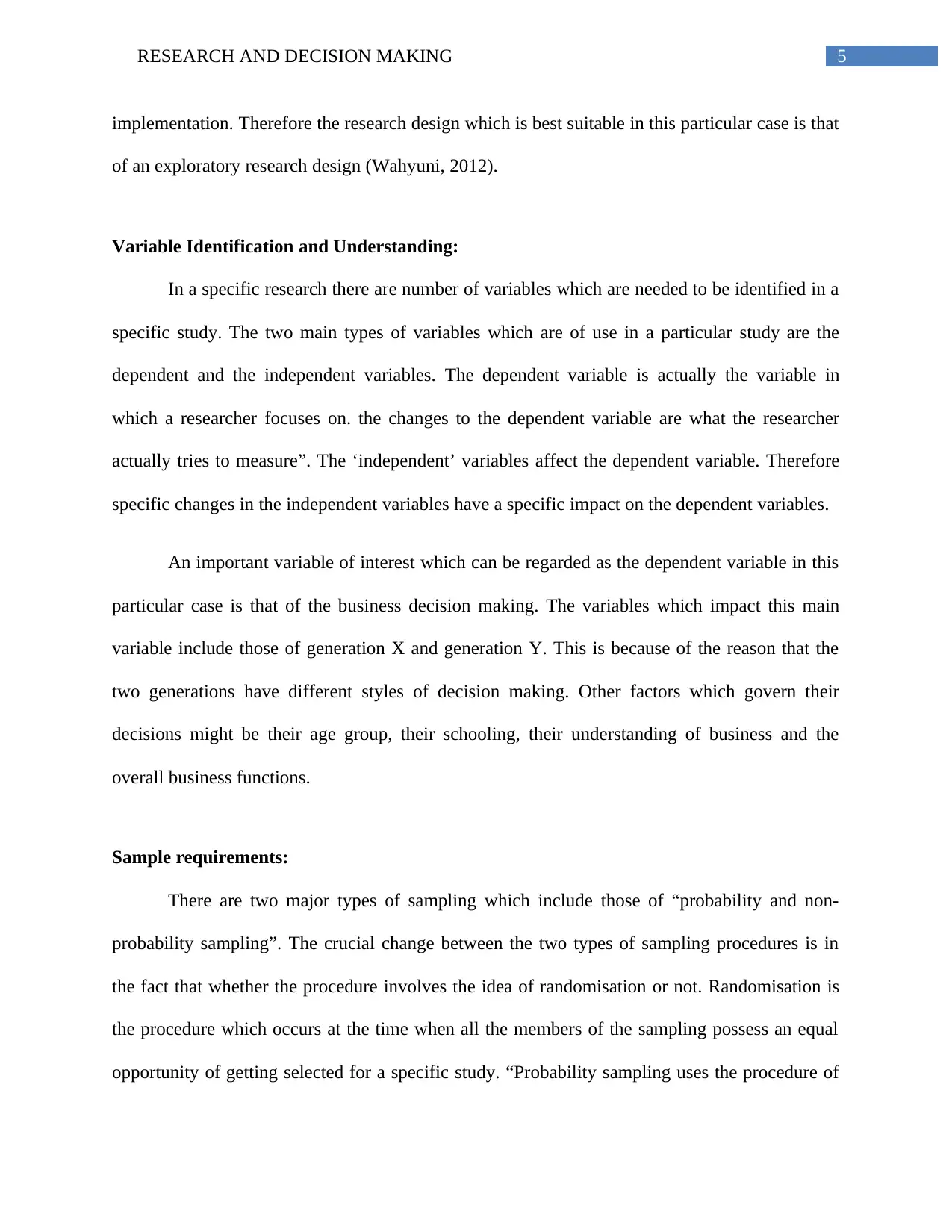
5RESEARCH AND DECISION MAKING
implementation. Therefore the research design which is best suitable in this particular case is that
of an exploratory research design (Wahyuni, 2012).
Variable Identification and Understanding:
In a specific research there are number of variables which are needed to be identified in a
specific study. The two main types of variables which are of use in a particular study are the
dependent and the independent variables. The dependent variable is actually the variable in
which a researcher focuses on. the changes to the dependent variable are what the researcher
actually tries to measure”. The ‘independent’ variables affect the dependent variable. Therefore
specific changes in the independent variables have a specific impact on the dependent variables.
An important variable of interest which can be regarded as the dependent variable in this
particular case is that of the business decision making. The variables which impact this main
variable include those of generation X and generation Y. This is because of the reason that the
two generations have different styles of decision making. Other factors which govern their
decisions might be their age group, their schooling, their understanding of business and the
overall business functions.
Sample requirements:
There are two major types of sampling which include those of “probability and non-
probability sampling”. The crucial change between the two types of sampling procedures is in
the fact that whether the procedure involves the idea of randomisation or not. Randomisation is
the procedure which occurs at the time when all the members of the sampling possess an equal
opportunity of getting selected for a specific study. “Probability sampling uses the procedure of
implementation. Therefore the research design which is best suitable in this particular case is that
of an exploratory research design (Wahyuni, 2012).
Variable Identification and Understanding:
In a specific research there are number of variables which are needed to be identified in a
specific study. The two main types of variables which are of use in a particular study are the
dependent and the independent variables. The dependent variable is actually the variable in
which a researcher focuses on. the changes to the dependent variable are what the researcher
actually tries to measure”. The ‘independent’ variables affect the dependent variable. Therefore
specific changes in the independent variables have a specific impact on the dependent variables.
An important variable of interest which can be regarded as the dependent variable in this
particular case is that of the business decision making. The variables which impact this main
variable include those of generation X and generation Y. This is because of the reason that the
two generations have different styles of decision making. Other factors which govern their
decisions might be their age group, their schooling, their understanding of business and the
overall business functions.
Sample requirements:
There are two major types of sampling which include those of “probability and non-
probability sampling”. The crucial change between the two types of sampling procedures is in
the fact that whether the procedure involves the idea of randomisation or not. Randomisation is
the procedure which occurs at the time when all the members of the sampling possess an equal
opportunity of getting selected for a specific study. “Probability sampling uses the procedure of
⊘ This is a preview!⊘
Do you want full access?
Subscribe today to unlock all pages.

Trusted by 1+ million students worldwide
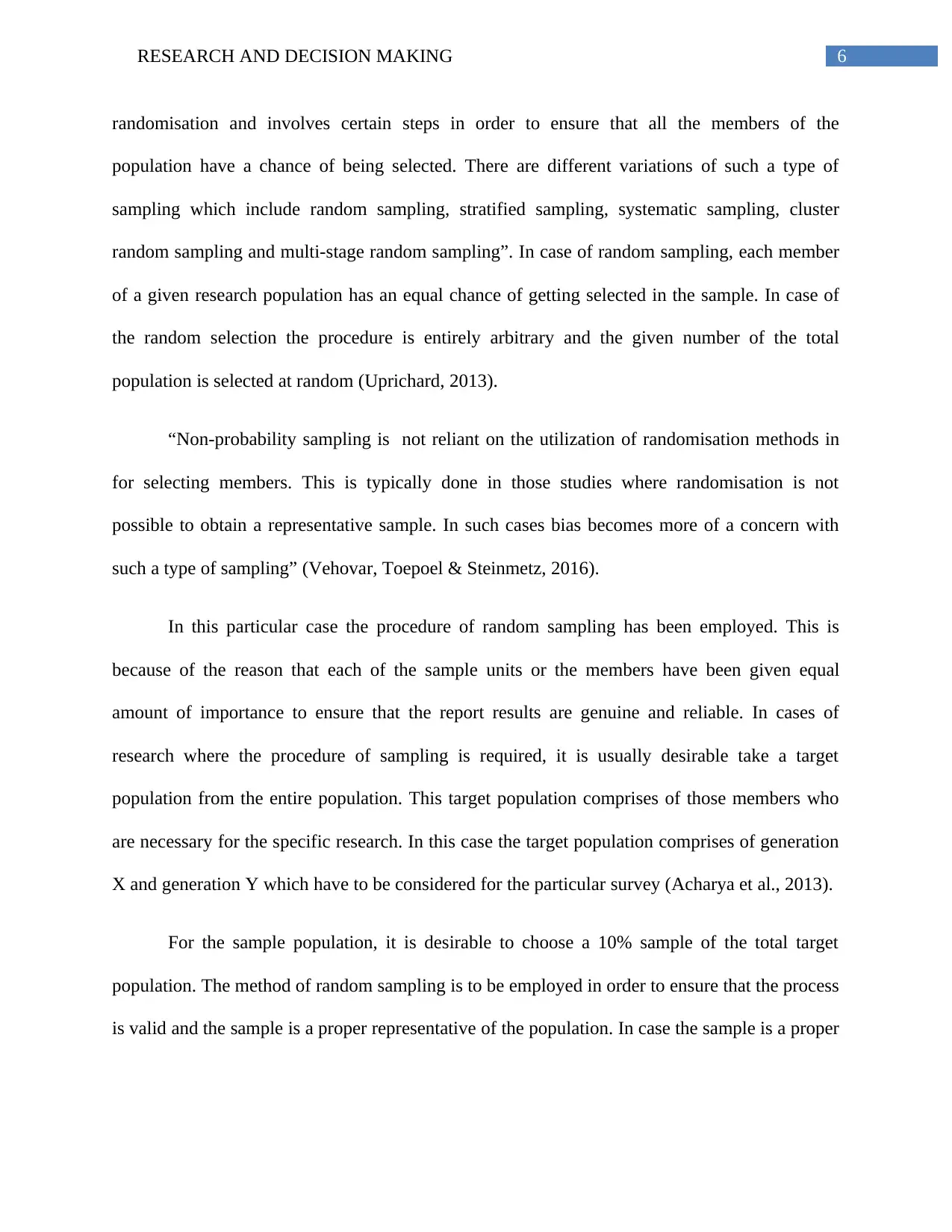
6RESEARCH AND DECISION MAKING
randomisation and involves certain steps in order to ensure that all the members of the
population have a chance of being selected. There are different variations of such a type of
sampling which include random sampling, stratified sampling, systematic sampling, cluster
random sampling and multi-stage random sampling”. In case of random sampling, each member
of a given research population has an equal chance of getting selected in the sample. In case of
the random selection the procedure is entirely arbitrary and the given number of the total
population is selected at random (Uprichard, 2013).
“Non-probability sampling is not reliant on the utilization of randomisation methods in
for selecting members. This is typically done in those studies where randomisation is not
possible to obtain a representative sample. In such cases bias becomes more of a concern with
such a type of sampling” (Vehovar, Toepoel & Steinmetz, 2016).
In this particular case the procedure of random sampling has been employed. This is
because of the reason that each of the sample units or the members have been given equal
amount of importance to ensure that the report results are genuine and reliable. In cases of
research where the procedure of sampling is required, it is usually desirable take a target
population from the entire population. This target population comprises of those members who
are necessary for the specific research. In this case the target population comprises of generation
X and generation Y which have to be considered for the particular survey (Acharya et al., 2013).
For the sample population, it is desirable to choose a 10% sample of the total target
population. The method of random sampling is to be employed in order to ensure that the process
is valid and the sample is a proper representative of the population. In case the sample is a proper
randomisation and involves certain steps in order to ensure that all the members of the
population have a chance of being selected. There are different variations of such a type of
sampling which include random sampling, stratified sampling, systematic sampling, cluster
random sampling and multi-stage random sampling”. In case of random sampling, each member
of a given research population has an equal chance of getting selected in the sample. In case of
the random selection the procedure is entirely arbitrary and the given number of the total
population is selected at random (Uprichard, 2013).
“Non-probability sampling is not reliant on the utilization of randomisation methods in
for selecting members. This is typically done in those studies where randomisation is not
possible to obtain a representative sample. In such cases bias becomes more of a concern with
such a type of sampling” (Vehovar, Toepoel & Steinmetz, 2016).
In this particular case the procedure of random sampling has been employed. This is
because of the reason that each of the sample units or the members have been given equal
amount of importance to ensure that the report results are genuine and reliable. In cases of
research where the procedure of sampling is required, it is usually desirable take a target
population from the entire population. This target population comprises of those members who
are necessary for the specific research. In this case the target population comprises of generation
X and generation Y which have to be considered for the particular survey (Acharya et al., 2013).
For the sample population, it is desirable to choose a 10% sample of the total target
population. The method of random sampling is to be employed in order to ensure that the process
is valid and the sample is a proper representative of the population. In case the sample is a proper
Paraphrase This Document
Need a fresh take? Get an instant paraphrase of this document with our AI Paraphraser
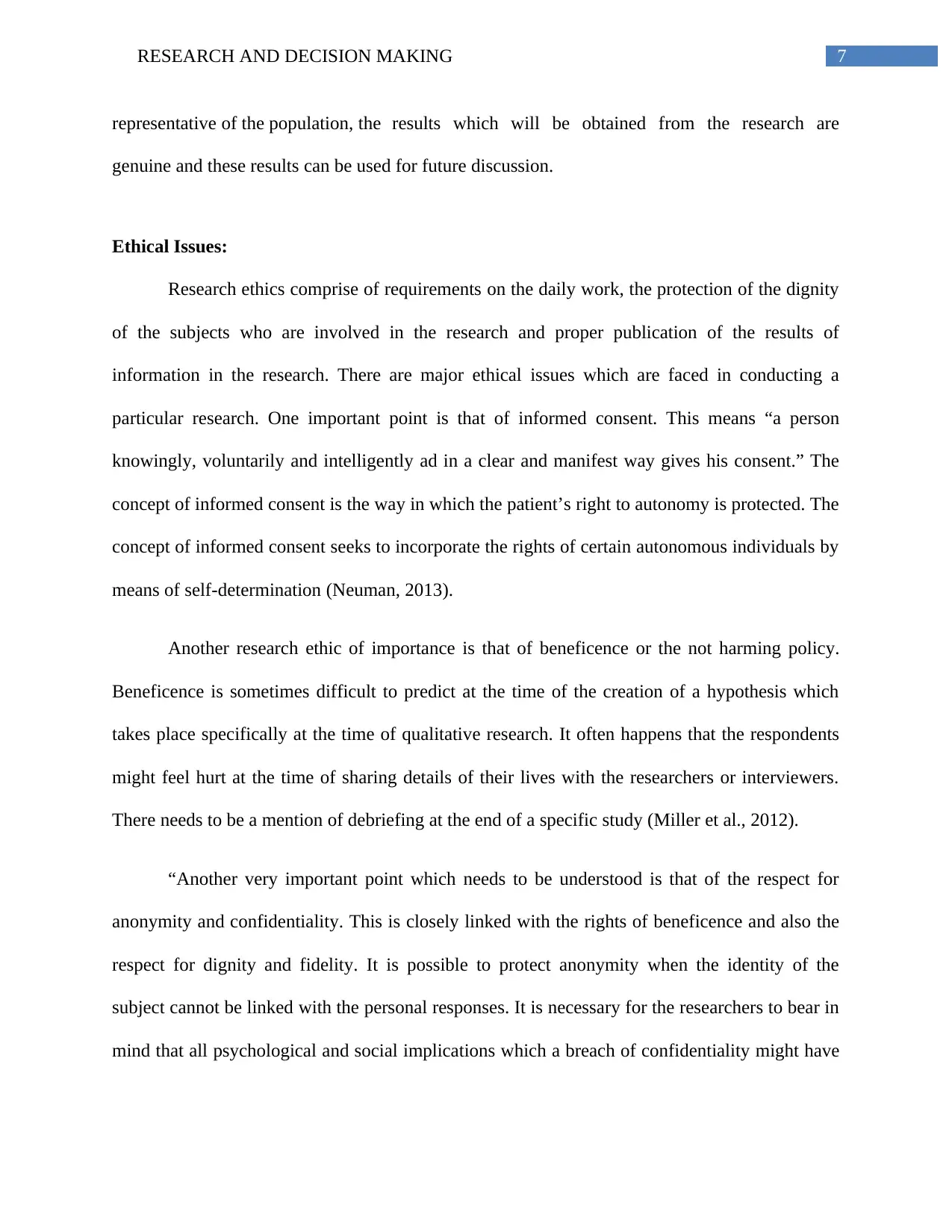
7RESEARCH AND DECISION MAKING
representative of the population, the results which will be obtained from the research are
genuine and these results can be used for future discussion.
Ethical Issues:
Research ethics comprise of requirements on the daily work, the protection of the dignity
of the subjects who are involved in the research and proper publication of the results of
information in the research. There are major ethical issues which are faced in conducting a
particular research. One important point is that of informed consent. This means “a person
knowingly, voluntarily and intelligently ad in a clear and manifest way gives his consent.” The
concept of informed consent is the way in which the patient’s right to autonomy is protected. The
concept of informed consent seeks to incorporate the rights of certain autonomous individuals by
means of self-determination (Neuman, 2013).
Another research ethic of importance is that of beneficence or the not harming policy.
Beneficence is sometimes difficult to predict at the time of the creation of a hypothesis which
takes place specifically at the time of qualitative research. It often happens that the respondents
might feel hurt at the time of sharing details of their lives with the researchers or interviewers.
There needs to be a mention of debriefing at the end of a specific study (Miller et al., 2012).
“Another very important point which needs to be understood is that of the respect for
anonymity and confidentiality. This is closely linked with the rights of beneficence and also the
respect for dignity and fidelity. It is possible to protect anonymity when the identity of the
subject cannot be linked with the personal responses. It is necessary for the researchers to bear in
mind that all psychological and social implications which a breach of confidentiality might have
representative of the population, the results which will be obtained from the research are
genuine and these results can be used for future discussion.
Ethical Issues:
Research ethics comprise of requirements on the daily work, the protection of the dignity
of the subjects who are involved in the research and proper publication of the results of
information in the research. There are major ethical issues which are faced in conducting a
particular research. One important point is that of informed consent. This means “a person
knowingly, voluntarily and intelligently ad in a clear and manifest way gives his consent.” The
concept of informed consent is the way in which the patient’s right to autonomy is protected. The
concept of informed consent seeks to incorporate the rights of certain autonomous individuals by
means of self-determination (Neuman, 2013).
Another research ethic of importance is that of beneficence or the not harming policy.
Beneficence is sometimes difficult to predict at the time of the creation of a hypothesis which
takes place specifically at the time of qualitative research. It often happens that the respondents
might feel hurt at the time of sharing details of their lives with the researchers or interviewers.
There needs to be a mention of debriefing at the end of a specific study (Miller et al., 2012).
“Another very important point which needs to be understood is that of the respect for
anonymity and confidentiality. This is closely linked with the rights of beneficence and also the
respect for dignity and fidelity. It is possible to protect anonymity when the identity of the
subject cannot be linked with the personal responses. It is necessary for the researchers to bear in
mind that all psychological and social implications which a breach of confidentiality might have

8RESEARCH AND DECISION MAKING
on each of the subjects. There always needs to be a respect for privacy that has to be maintained
at all times (Kono, 2012)”.
on each of the subjects. There always needs to be a respect for privacy that has to be maintained
at all times (Kono, 2012)”.
⊘ This is a preview!⊘
Do you want full access?
Subscribe today to unlock all pages.

Trusted by 1+ million students worldwide
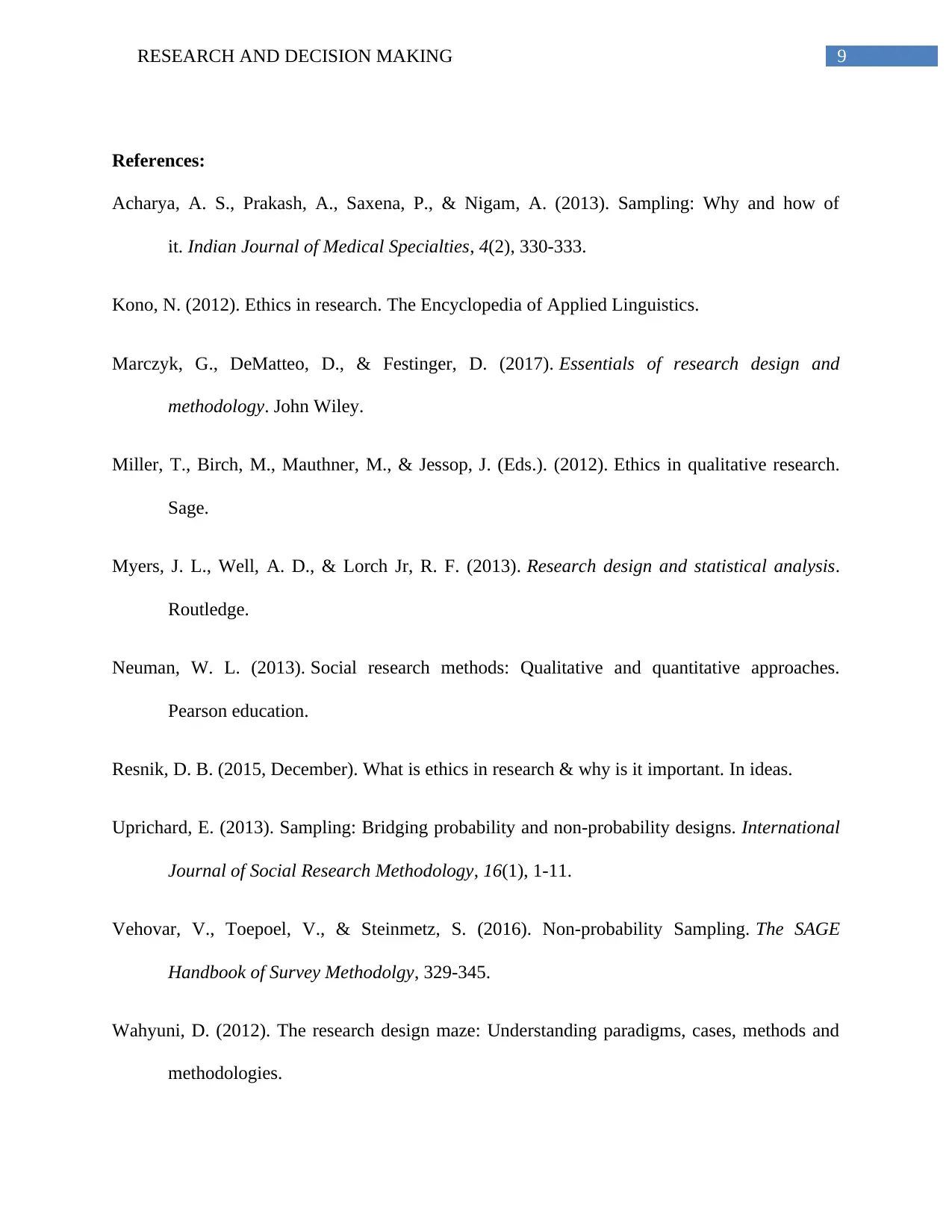
9RESEARCH AND DECISION MAKING
References:
Acharya, A. S., Prakash, A., Saxena, P., & Nigam, A. (2013). Sampling: Why and how of
it. Indian Journal of Medical Specialties, 4(2), 330-333.
Kono, N. (2012). Ethics in research. The Encyclopedia of Applied Linguistics.
Marczyk, G., DeMatteo, D., & Festinger, D. (2017). Essentials of research design and
methodology. John Wiley.
Miller, T., Birch, M., Mauthner, M., & Jessop, J. (Eds.). (2012). Ethics in qualitative research.
Sage.
Myers, J. L., Well, A. D., & Lorch Jr, R. F. (2013). Research design and statistical analysis.
Routledge.
Neuman, W. L. (2013). Social research methods: Qualitative and quantitative approaches.
Pearson education.
Resnik, D. B. (2015, December). What is ethics in research & why is it important. In ideas.
Uprichard, E. (2013). Sampling: Bridging probability and non-probability designs. International
Journal of Social Research Methodology, 16(1), 1-11.
Vehovar, V., Toepoel, V., & Steinmetz, S. (2016). Non-probability Sampling. The SAGE
Handbook of Survey Methodolgy, 329-345.
Wahyuni, D. (2012). The research design maze: Understanding paradigms, cases, methods and
methodologies.
References:
Acharya, A. S., Prakash, A., Saxena, P., & Nigam, A. (2013). Sampling: Why and how of
it. Indian Journal of Medical Specialties, 4(2), 330-333.
Kono, N. (2012). Ethics in research. The Encyclopedia of Applied Linguistics.
Marczyk, G., DeMatteo, D., & Festinger, D. (2017). Essentials of research design and
methodology. John Wiley.
Miller, T., Birch, M., Mauthner, M., & Jessop, J. (Eds.). (2012). Ethics in qualitative research.
Sage.
Myers, J. L., Well, A. D., & Lorch Jr, R. F. (2013). Research design and statistical analysis.
Routledge.
Neuman, W. L. (2013). Social research methods: Qualitative and quantitative approaches.
Pearson education.
Resnik, D. B. (2015, December). What is ethics in research & why is it important. In ideas.
Uprichard, E. (2013). Sampling: Bridging probability and non-probability designs. International
Journal of Social Research Methodology, 16(1), 1-11.
Vehovar, V., Toepoel, V., & Steinmetz, S. (2016). Non-probability Sampling. The SAGE
Handbook of Survey Methodolgy, 329-345.
Wahyuni, D. (2012). The research design maze: Understanding paradigms, cases, methods and
methodologies.
1 out of 10
Related Documents
Your All-in-One AI-Powered Toolkit for Academic Success.
+13062052269
info@desklib.com
Available 24*7 on WhatsApp / Email
![[object Object]](/_next/static/media/star-bottom.7253800d.svg)
Unlock your academic potential
Copyright © 2020–2025 A2Z Services. All Rights Reserved. Developed and managed by ZUCOL.





